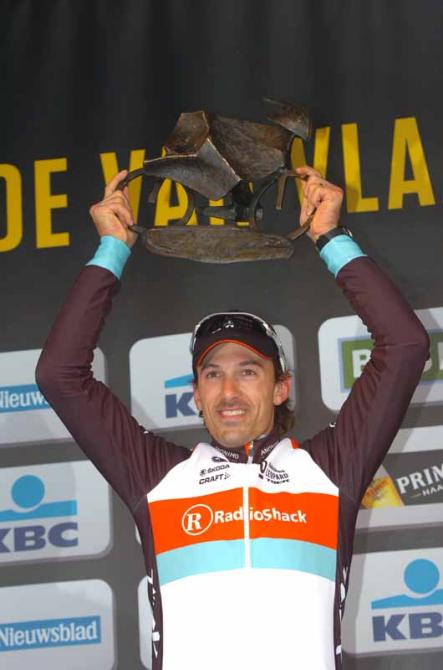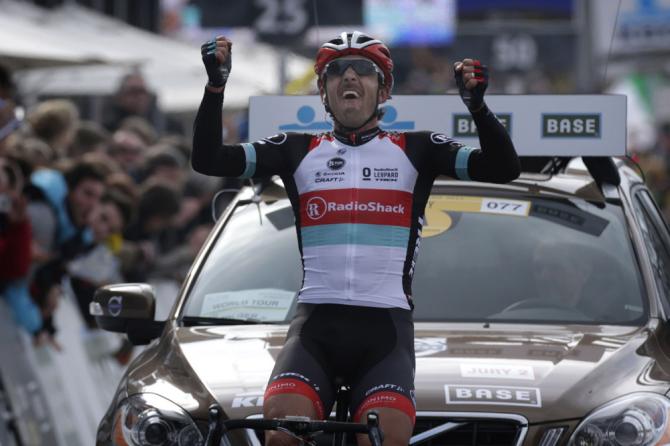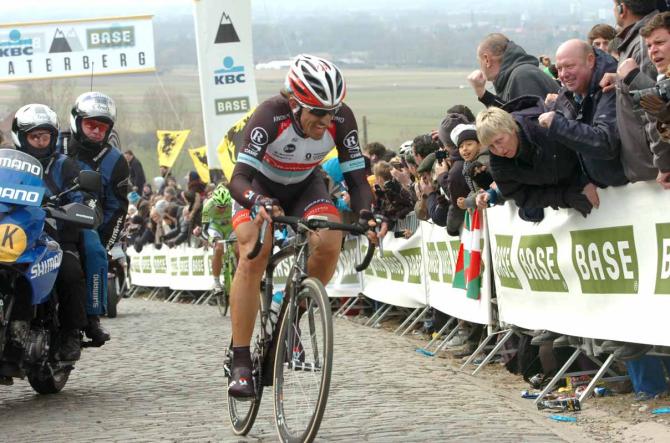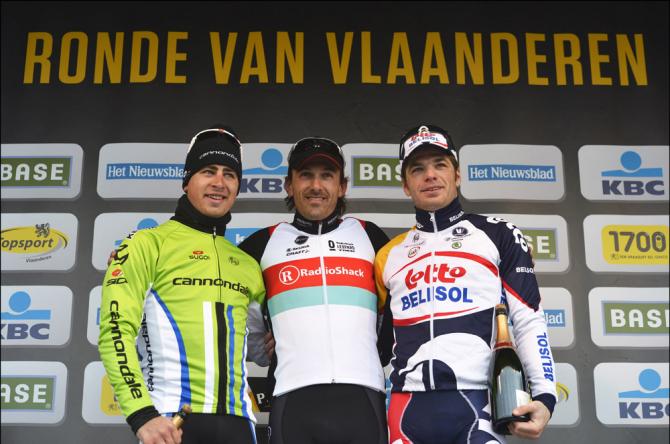Cancellara: “I hope Belgium is happy with my win”
RadioShack rider on Boonen, Sagan and his knock out blow to win Flanders




The Tour of Flanders had been billed as a something of a prize fight, and after three rounds over the Oude Kwaremont and Paterberg, it was the experienced slugger Fabian Cancellara who prevailed over the young contender Peter Sagan to claim victory, with a knock-out victory.
Tom Boonen crashes out of Tour of Flanders
Vos wins Women's Tour of Flanders
Race tech: New Scott Addict at Tour of Flanders
Cancellara wins Tour of Flanders
Roelandts uses team tactics to finally show his class
Sagan: “I wasn’t able to hold Cancellara on the last climb”
Gallery: Cancellara celebrates with his Flemish fan club
Paolini ponders Cancellara problem ahead of Paris-Roubaix
Cancellara crash "not ideal situation" ahead of Paris-Roubaix, says Guercilena
In Oudenaarde’s main square after the race, RadioShack-Leopard manager Luca Guercilena acknowledged the race for what it had been – a protracted duel between the two strongest riders.
“In the end Fabian won like it was a boxing match,” Guercilena said. “The old guy beat the young boxer with a knock-out punch,” he said.
That telling blow arrived on the final ascent of the Paterberg, but Cancellara had already begun the softening up process by hitting the front on the Oude Kwaremont just beforehand. He had exposed a chink in Sagan’s defences on the same climb at E3 Harelbeke last week, although this time the Slovak proved more resilient to Cancellara’s initial probing.
“I accelerated the first time to see what would happen, as we were still in a big group,” Cancellara said of the move that brought him and Sagan up to the wheel of escapee Jurgen Roelandts (Lotto Belisol) as they approached the Paterberg.
Before the race, no less a figure than Tom Boonen had speculated that Sagan would be the quickest man up the Paterberg, but on the short but steep wall, it was Cancellara who began to wear down his rival’s resistance. An exploratory jab suggested that Sagan’s legs were wobbling, and the decisive combination arrived near the summit.
“I was alone with Peter. I wouldn’t say that I accelerated exactly, but I put it a bit harder to see his reaction,” Cancellara said, matter-of-factly explaining how he watched Sagan’s front wheel slip out of range of his peripheral vision. “I was looking for him, I could see his wheel falling back so I just continued.”
Get The Leadout Newsletter
The latest race content, interviews, features, reviews and expert buying guides, direct to your inbox!
Although the gap was just a handful of seconds when Cancellara swung left atop the Paterberg, the final 13 kilometres proved little more than a prolonged procession, a time trial to the finish, as the Swiss rider stretched out his lead to some 1:27 by the finish.
On Easter Sunday three years ago, the disarming facility with which Cancellara dispatched of Tom Boonen on the Muur to win on the old course raised eyebrows and wild accusations of electric motors. This time around, Cancellara was seemingly again on another planet: the ease with which he pulled away from the chasers on the wide, exposed run-in to Oudenaarde was startling.
“The old course had a lot of emotion with the Muur and the Bosberg, but things change in cycling,” Cancellara said. “The last 10km were good for me today because they meant that I could pull away, although I think a smaller road would be better for the finale. But we have to live with that, and I’m just happy to have won on both courses.”
Praise for Sagan
Ahead of Milan-San Remo, Cancellara had chastised Sagan mildly for his exuberant victory celebrations and for his failure to collaborate when the pair escaped on the opening road stage of last year’s Tour de France. The contrast between the worldviews of the older and supposedly more austere Cancellara and the young, insouciant Sagan had generated plenty of column inches in the build-up to De Ronde.
After fending off his young foe, however, Cancellara had nothing but praise for Sagan when they sat side by side in front of the television cameras near the finish, acknowledging that the Cannondale rider had collaborated with him on the Kwaremont.
“He didn’t have to do it. He has to do my race and I have to do mine. Everybody said it going to be Peter Sagan against me, and that meant his team and my team had to take responsibility.”
Indeed, the RadioShack Leopard team defied pre-race expectations that it would prove to be Cancellara’s Achilles heel. Hayden Roulston put in a mammoth stint on the first circuit over the final two climbs, while a seemingly reanimated Stijn Devolder played a hugely prominent part in the race’s endgame.
“In 2011, I was also strong but they destroyed my team early, so I told the guys it was important for me not to be alone in the finale,” Cancellara said. “The guys were super strong. Hayden and Stijn led on the laps. We really wanted to control the part after the Kwaremont and Paterberg, to stop any attacks there.”
Cancellara also had a thought for his eternal rival Tom Boonen, who was left sprawling on the canvass by a crash during the frantic opening hour of racing.
“I was almost next to him when he fell, and it was a very sad moment to see Tom crash,” he said, remembering his own crash in the 2012 Tour of Flanders.
“For a few minutes I was just empty, because I remembered what happened to me last year. It was not the Easter day that the race wanted, but I hope Belgium is happy with my win.”
Thoughts turn now to Paris-Roubaix. With both Boonen (injured) and Sagan (resting for Amstel Gold Race) among the absentees, there appears to be a paucity of contenders to go toe to toe with Cancellara on the pavé as he seeks the second Flanders-Roubaix double of his career.
“On paper, it’s easy, it’s predictable for you [the press] already, but it’s still another race,” Cancellara said. “People talk about next week, but I want to enjoy today. You never know what is tomorrow.”

Barry Ryan was Head of Features at Cyclingnews. He has covered professional cycling since 2010, reporting from the Tour de France, Giro d’Italia and events from Argentina to Japan. His writing has appeared in The Independent, Procycling and Cycling Plus. He is the author of The Ascent: Sean Kelly, Stephen Roche and the Rise of Irish Cycling’s Golden Generation, published by Gill Books.